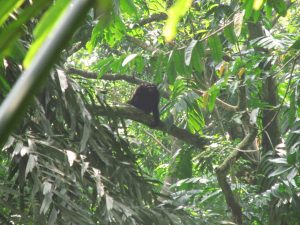What does it take to make a community aware of conservation of an endangered species? In Hima Malai Sohmat, it takes only a group of dedicated people and a folktale.
The Hima, comprising 13 villages under Mawsynram sub-division, is home to Hoolock Gibbons. In fact, the gibbons “mark the territory of the Hima”. For decades, the villagers had peacefully coexisted with the animals. But in the last more than two decades, the population of the gibbons, locally called huleng, has fallen drastically owing to rampant hunting. Recently, the Hima dorbar passed a resolution to save the endangered species and renew the healthy coexistence.
The folktale
The virgin forests in the Hima have been the habitat of Hoolock Gibbons for time immemorial. They would come into the human colony and were friendly, remembers 75-year-old Planston Iawrod, a village elder at Phlangwanbroi, one of the villages under Malai Sohmat.
Iawrod, who is also a member of the Malai Sohmat Tourism and Multipurpose Cooperative Society (MSTMCS) that works for the conservation of the gibbons and other wild animals in the region, narrates the tale that has become a part of people’s life in the region.

“Long time ago, there was a lazy girl who would never listen to her mother. Whenever the mother gave her any work she would complain. She always wanted to run away to the jungle. So one day the mother got angry and threw her saipan (belt) towards her. That gave her a scar near the eyebrow. We believe that the girl turned into a Hoolock Gibbon. Gibbons have a mark near the eyebrows and that is the scar from the saipan. Even today, mothers tell their daughters not to be lazy or they will turn into gibbons,” the elderly man explains the importance of Hoolock Gibbons in the life of the indigenous people in the Hima.
It is also believed that the creatures mark the territory of the Hima. “There is enough reason to believe this as one side (of the Hima) is close to Bangladesh and the other is separated by a deep gorge. So the gibbons do not cross that territory that is the Hima Malai Sohmat area,” says Tyngshain Dewkhaid, secretary of the MSTMCS.
The killing & awareness
Though locals in the Hima knew the stories about gibbons, outsiders (in this case, men who came to the villages in the region after marriage) were oblivious to such beliefs. For them, killing a wild animal was show of strength and a source of recreation.
“None of the locals kills the animal even to this day as we know the tradition. But those who came from outside did it for food. And some people with vested interests encouraged them. They never sold the meat in the market fearing stringent action against them,” says Dewkhaid.
In fact, one more gibbon was shot before Christmas and the society and Hima members found the dead animal. But no action has been taken so far as “there is no evidence”, says the Hima’s acting Syiem Brassing Dewsaw.
“The population of the animals was large when I was a child. You could often see them even in the villages. But they rarely come out these days as they are scared of humans now after the killings which have been going on for years,” says Iawrod.
In Meghalaya, Hoolocks, which are endangered, are found in the Hima Malai Sohmat region, the Nongkhyllem Wildlife Sanctuary in Ri Bhoi and the Nokrek Biodiversity Park in the Garo Hills.
“I have heard from elders that these primates were never destructive even when they lived near the human habitation here… we have measured the distance of the gibbons’ horizontal leap and it is around 6 ft,” informs Banshimsuphen Wanniang, the 22-year-old member of the MSTMCS.
Wanniang has photographed as well as videographed the primates during one of his expeditions. “I do not understand why people kill them even after knowing that their population is on a decline,” the despair in his voice is palpable.
About three years ago, MSTMCS, which was formed in 2008 and has 30 members today, and the Hima realised the need for conserving the species and started their awareness programme. On December 14 last year, the Hima officially declared its intention to save the gibbons from the cruelty of a section of the villagers.
“Though the awareness started in 2017-18, the resolution was passed last year and now the volunteers and experts visit the villages (under Malai Sohmat) to make people aware of the need to save wildlife,” says Dewsaw.
In their endeavour, Conservation Initiatives, a Shillong-based wildlife conservation organisation, has been a major support from the beginning. Biang Syiem, who is involved in gibbon research and conservation in the area, says, “Our work involves collecting scientific information on the distribution of the western Hoolock Gibbon in the forests of the Hima as well as conducting conservation awareness programmes in the villages of the Hima. This work is being headed by Dr Divya Vasudev and Dr Varun Goswami.”
The researcher adds that there are a few individuals from Shillong, like Zorba Laloo, who have been involved in the efforts from the beginning.
Villagers’ response
Five villages — Mawkasain, Phlangwanbroi, Kenba Malai, Mawrapad and Mawsawa — are part of the awareness and conservation initiatives.
Dewsaw, who is earnestly trying to bring about a change in the mindset of people in his region, says when the awareness started, the response was “very poor” but over months, things have started to change.
“There is 90 per cent awareness now in the five villages. In 2018, we could stop 40-50 per cent of gibbon hunting,” maintains Dewkhaid.
The current population of the gibbons is yet to be ascertained but Wanniang says there may be around 20 of them in one part of the jungle. The local conservationists have already put sound trackers and cameras in some parts of the forests for the purpose. “We are planning to put more cameras. We are using the society’s fund and the Conservation Initiatives is also helping us with equipment like laptops and projector,” informs Dewkhaid.

The projector has helped the conservationists to vividly explain to villagers about the animal and this has proved to be a better medium to convince them.
The positive side of the entire programme is that the youth are actively participating. Some like Wanniang have taken special training in wildlife conservation. “Now, even children in many villages know about gibbon conservation,” says the syiem.
The Hima has also put a penalty of Rs 5,000 for gibbon hunting. So far, neither the Hima nor MSTMCS has taken any stringent action against law breakers but “we should opt for legal action if villagers defy the regulations”, says Dewkhaid.
Besides gibbons, the Hima is also spreading awareness on conservation of the forests and other wild species found there. The conservation of the dense jungle becomes imperative to protect the habitat of the primates.
The stakeholders have set a target of three years for complete awareness in the Hima region. According to Dewsaw, the Hima is also contemplating wildlife and adventure tourism once the target is achieved.
It is a mammoth task, especially in the absence of any assistance from the government, but the Hima and MSTMCS are determined. “We are sure that in the next five years we can see a perceptible change. We will definitely be successful in saving the gibbons,” says Pynshai Kynter, the assistant secretary of the society.
~ Nabamita Mitra
Photos by ST Photo of Hoolock Gibbon by Banshimsubhen Wanniang



